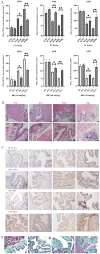Aldh2 gene reduces oxidative stress in the bladder by regulating the NF-κB pathway in a mouse model of ketamine-induced cystitis
- PMID: 33005240
- PMCID: PMC7523278
- DOI: 10.3892/etm.2020.9239
Aldh2 gene reduces oxidative stress in the bladder by regulating the NF-κB pathway in a mouse model of ketamine-induced cystitis
Abstract
Aldehyde dehydrogenase 2 (aldh2) serves an important role in the development of organ injury. Therefore, the present study investigated the effects of aldh2 on the oxidative stress response in a mouse model of ketamine-induced cystitis (KIC). A total of 60 8-week-old male Institute of Cancer Research wild-type (WT) mice and 45 aldh2 knock-out (KO) mice were randomized to receive low-dose ketamine (30 mg/kg), high-dose ketamine (60 mg/kg) or normal saline (controls). At 4, 8 and 12 weeks post-injection, bladder tissues were harvested and used to investigate the protective mechanisms of aldh2 on bladder function. The results demonstrated that aldh2 KO mice exhibited significant weight loss following chronic ketamine injection compared with that in WT mice. Furthermore, ketamine treatment increased the urination rate (P<0.05), pathological score (P<0.05), levels of the oxidative stress product malondialdehyde (P<0.05) in addition to reducing the expression of the anti-oxidative stress enzyme superoxide dismutase (P<0.05) and glutathione-SH (P<0.05). Oxidative stress in aldh2 KO mice was also found to significantly enhance the expression of proteins associated with the NF-κB signaling pathway, which promoted the expression of inducible nitric oxide synthase (P<0.05) and cyclooxygenase-2 (P<0.05) further. Finally, aldh2 KO mice demonstrated higher severity of fibrosis in the submucosal and muscular layers of the bladder. In conclusion, the present study suggests that aldh2 serves a protective role in preventing inflammation and fibrosis in KIC.
Keywords: aldehyde dehydrogenase 2; cyclooxygenase-2; inducible nitric oxide synthase; ketamine-induced cystitis; oxidative stress.
Copyright: © Xi et al.
Figures



Similar articles
-
Translocation of NF-κB and expression of cyclooxygenase-2 are enhanced by ketamine-induced ulcerative cystitis in rat bladder.Am J Pathol. 2015 Aug;185(8):2269-85. doi: 10.1016/j.ajpath.2015.04.020. Epub 2015 Jun 12. Am J Pathol. 2015. PMID: 26073037
-
Metabolic remodeling induced by mitochondrial aldehyde stress stimulates tolerance to oxidative stress in the heart.Circ Res. 2009 Nov 20;105(11):1118-27. doi: 10.1161/CIRCRESAHA.109.206607. Epub 2009 Oct 8. Circ Res. 2009. PMID: 19815821
-
Dual involvements of cyclooxygenase and nitric oxide synthase expressions in ketamine-induced ulcerative cystitis in rat bladder.Neurourol Urodyn. 2013 Nov;32(8):1137-43. doi: 10.1002/nau.22367. Epub 2013 Jan 28. Neurourol Urodyn. 2013. PMID: 23359243
-
Possible pathophysiology of ketamine-related cystitis and associated treatment strategies.Int J Urol. 2015 Sep;22(9):816-25. doi: 10.1111/iju.12841. Epub 2015 Jun 18. Int J Urol. 2015. PMID: 26087832 Review.
-
Rodent models of ketamine-induced cystitis.Neurourol Urodyn. 2021 Sep;40(7):1704-1719. doi: 10.1002/nau.24763. Epub 2021 Aug 5. Neurourol Urodyn. 2021. PMID: 34350618 Review.
Cited by
-
Aldehyde dehydrogenase 2 alleviates monosodium iodoacetate-induced oxidative stress, inflammation and apoptosis in chondrocytes via inhibiting aquaporin 4 expression.Biomed Eng Online. 2021 Aug 6;20(1):80. doi: 10.1186/s12938-021-00917-0. Biomed Eng Online. 2021. PMID: 34362382 Free PMC article.
-
A novel risk score model based on five angiogenesis-related long non-coding RNAs for bladder urothelial carcinoma.Cancer Cell Int. 2022 Apr 19;22(1):157. doi: 10.1186/s12935-022-02575-1. Cancer Cell Int. 2022. PMID: 35440045 Free PMC article.
-
ALDH2 Overexpression Improves the Blood-brain Barrier and Represses Mitochondrial Dysfunction in Chronic Cerebral Hypoperfusion Through the SIRT1/ROS Axis.Neurochem Res. 2025 Feb 18;50(2):102. doi: 10.1007/s11064-025-04353-7. Neurochem Res. 2025. PMID: 39964551
-
NADPHnet: a novel strategy to predict compounds for regulation of NADPH metabolism via network-based methods.Acta Pharmacol Sin. 2024 Oct;45(10):2199-2211. doi: 10.1038/s41401-024-01324-6. Epub 2024 Jun 20. Acta Pharmacol Sin. 2024. PMID: 38902503
References
-
- Parkin MC, Turfus SC, Smith NW, Halket JM, Braithwaite RA, Elliott SP, Osselton MD, Cowan DA, Kicman AT. Detection of ketamine and its metabolites in urine by ultra high pressure liquid chromatography-tandem mass spectrometry. J Chromatogr B Analyt Technol Biomed Life Sci. 2008;876:137–142. doi: 10.1016/j.jchromb.2008.09.036. - DOI - PubMed
-
- Liu KM, Chuang SM, Long CY, Lee YL, Wang CC, Lu MC, Lin RJ, Lu JH, Jang MY, Wu WJ, et al. Ketamine-induced ulcerative cystitis and bladder apoptosis involve oxidative stress mediated by mitochondria and the endoplasmic reticulum. Am J Physiol Renal Physiol. 2015;309:F318–F331. doi: 10.1152/ajprenal.00607.2014. - DOI - PubMed
LinkOut - more resources
Full Text Sources
Research Materials
Miscellaneous
